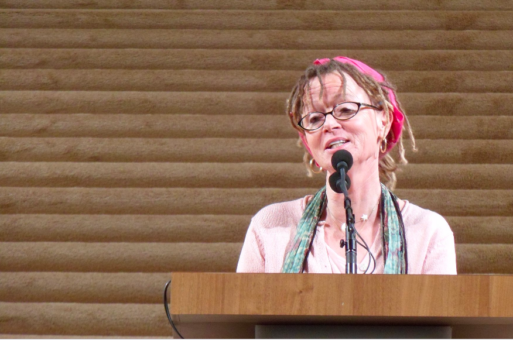
Anne Lamott’s essays on life (and death) in “Almost Everything” sound a bit like Ensign Nellie Forbush’s self-proclaimed cockeyed optimism amidst perilous times in Rogers and Hammerstein’s “South Pacific.” Just as World War II endangers the lives of nurse Nellie and her cast members in the classic musical, Lamott repeatedly wonders if she might wake up one morning to find the U.S. has bombed North Korea. Still, as Anne sets out to write everything she knows about almost everything (in less than 200 pages), readers have the opportunity to take on her perspective of our fragile world — viewing it, like Anne, as a glass-half-full instead of half empty.

Credit: Zach Dischner via Wikimedia.org
Just this spring, on the occasion of the 65-year-old writer’s first marriage, the New York Times called Anne “a natural cheerleader, especially for underdogs,” a group to which she personally relates. Readers often feel a kinship with her– one that inspires referring to her on a first-name basis — after reading the honest accounts of her own experiences with alcoholism, single motherhood, faith crises and renewals, loss, and self-esteem. She has explored just about every life challenge that goes with the profile of being human in her 11 books of non-fiction, all with a brand of wisdom wrapped in the self-effacing humor that has become her trademark.
Early on in this profound yet funny book, Lamott addresses — head on — the contradiction of hawking hope during these trying and (some would say) desperate times. She admits, “I am stockpiling antibiotics for the Apocalypse, even as I await the blossoming of paperwhites on the windowsill in the kitchen.” Oddly enough, she actually considered titling the book “Doomed” before redirecting the book cover’s focus to “Notes on Hope” about “Almost Everything” that dampens our outlook these days. These killjoys include news events, family issues, and the personal angst and battles that affect us all. But even when life is at its bleakest–when we are, as she puts it, “doomed, stunned, exhausted, and over-caffeinated –the seeds of rejuvenation are at hand.”
Her “In the Garden” essay — Chapter Eight in the book — tackles human mortality more deeply than her past memoirs. The narrative starts with an older friend asking her to share three things she would like younger people who fear death to know about dying. Anne answers by admitting she mostly views death as a “change of address.” Then she lets go of the light, breezy voice her audience knows so well, to get serious about the times she has “been on hand to help people cross over, been there for days and months at the end of a person’s life.” Her three takeaways are:
- While she would prefer that all deaths be swift and sweet, without dementia or pain, “every death has been rather beautiful.”
- The more time she spent in the presence of death, the less she feared it. One’s life is greatly enhanced by spending time with people who are dying even though we’ve been taught to avoid doing so.
- “Death is not the enemy. Snakes are. And cheese,” she says, returning to the tone that is uniquely hers.
 Then in true Anne Lamott fashion – she slips in a few other lessons learned.
Then in true Anne Lamott fashion – she slips in a few other lessons learned.
“Anytime you investigate how scary and bad loss is, it becomes a lot less bad, and a lot less bad is a small miracle. The great paradox is that drawing nearer to death will help begin to put it in the rearview mirror. Then instead of living in unconscious fear of its arrival, crashing our party, we accept it as one of the musicians, like the old donkey on his way to Bremen to play the lute.”
Whether her focus is life, death, addiction, self-image, or any of life’s Big Questions, “All truth is paradox,” according to Anne Lamott. She goes on to explain that “this turns out to be a reason for hope. If you arrive at a place in life that is miserable, it will change.”
A cockeyed optimist you say? For sure! But a smart, creative, and thoughtful one worth a listen… or two… or three.

 “Almost Everything” by Anne Lamott
“Almost Everything” by Anne Lamott


 Funeral Favors Offer Visitors a Tangible Memento
Funeral Favors Offer Visitors a Tangible Memento
 “Comeback” by Prince
“Comeback” by Prince















